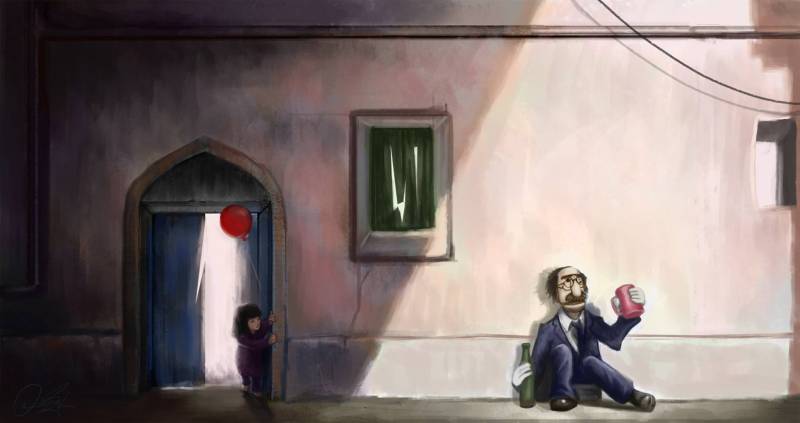A few days back, Omar Gilani, a modern, self-taught artist of Pakistan presented his painting titled Uncle Sargam on social media, which won the hearts of many and inclined them to recall their childhood days. The presence of Uncle Sargam in the painting was enough to catch people’s attention, even of those who are not able to appreciate a piece of art from a critical eye.
Uncle Sargam was a comic character produced back in the 80s by the cartoonist and puppeteer Farooq Qaiser. Uncle Sargam, unlike the modern comic characters who have a number of gadgets attached to their bodies, enabling them to perform acts which one can call “unreal”, was an enlightened character not dwelling in a fantastical world-oblivious to the real ongoing circumstances. He, through his creator’s satirical dialogues would make people aware of what was going around them, and whether it was propitious for their country or not. He addressed socio-political issues with the help of humor’s veil such as poverty, corruption in certain departments, capitalism etc. highlighting them in a subtle manner. Uncle Sargam was an inspiration for both children and adults in the way that where his cartoonish features such as a bald head, accompanied by an extra-large nose with rounded goggles resting on it and a bushy moustache would appeal to the children, his satirical criticism on the country’s problems would inculcate awareness among the adults.
Omar Gilani’s painting depicts Uncle Sargam lying exhausted against a house’s wall, with a jug in one hand and a bottle in the other, giving the image of a tired, thirsty person. Apart from this, he is being secretly watched by a girl standing at her door, holding a balloon in her hand. What Omar has to say regarding his painting is that it depicts how Uncle Sargam would have been in the current age: lonely and dejected.
A probable reason behind the artist’s idea may be that children of today are not attracted by any innocent looking cartoon whose objective is to instruct or inculcate morality, but go for cartoons having pointy facial features and spiked hair, who through their gadgets can achieve things unattainable in real life, arousing curiosity among children of a very dangerous sort. If not by such cartoons, they are attracted by mobile phones, laptops and tablets, which consume a lot of their time that can be spent in healthy activities.
The idea that Uncle Sargam is being watched by a girl with a balloon is significant in the way that it makes us question if the girl in the painting is unlike her peers, for her innocence is evident from the fact that she is playing with a balloon instead of a gadget. She can be considered a child possessing a unique temperament as a result of which Uncle Sargam has not gone unnoticed by her.
Is she concerned for him? Does he appeal to her? We find pleasure in trying to imagine what the girl would have done had it been a story instead of a painting. Would she have talked to him, asked him who he was or played with him? Seeing him miserable, she might have invited him in for rest and her parents would have told their daughter who the uncle is.
There is an element of beauty attached to every aspect of the painting. It seems like a perfect admirable piece of art owing to its aesthetic appeal coming from a big, plain wall, half washed in sunlight and half shadowed, an arched door and a curtained window. Its simplicity equally appeals, which arrives from the use of very light and few colours, majorly various shades of white with a contrast of red, and two adorable characters.
What gives the painting its indigenous touch is the raised platform formed with the help of a few bricks on which Uncle Sargam happens to be sitting. Such loosely built platforms can be commonly found in the alleys of Pakistan. Besides, the architecture incorporating arched doors and windows dates back to the Mughal era, a few examples of which are extant in the walled cities of our country. The idea that Uncle Sargam has found resort in an area that does not seem to be posh makes us think that he has come here in the hope of finding attention among children who do not have access to expensive gadgets, as a consequence of which he might intrigue them.
Omar Gilani must be commended for depicting through this simple artwork, a wide range of deplorable aspects: from deviation from morality to the desire of material things. He has done his work of making us recall Uncle Sargam. Now it is our duty not to stay engrossed in the reverie of our own childhoods, but to tell our children or our youngsters who this uncle was, and inculcate feelings of veneration for Uncle Sargam in their hearts, for he endeavoured to enlighten us and make us aware of the wrong acts being perpetrated around us. Can we forget him so easily?






